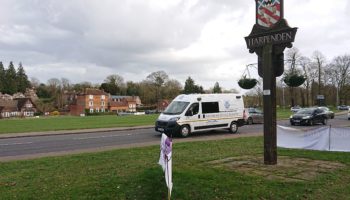
There is no one-fits-all solution for DRT services. The introduction of new mobility systems in a specific area requires a great deal of expertise and precise analysis to ensure that services are successful, i.e. that they meet customer and user needs in the best possible way. Transport consulting is therefore a key area for Padam Mobility. In-house mobility consultants and engineers help customers develop the on-demand service that can best solve their existing public transport problems.
One of these mobility experts is Xuefei Wang. Xuefei has been working at Padam Mobility for four years, starting as Customer Success Manager. His intensive experience in multiple areas of the company makes him one of the most experienced mobility consultants at Padam today. In the interview, he told us more about his passion for transport consulting. We also talked about which steps are necessary to be able to create the perfect service design. Among other things, we touched on the importance of data and the courage to innovate.
How did you come to Padam Mobility and what is your job like today?
I have been working at Padam for over 4 years now. I started as an intern in the Customer Success Team and then worked as a Customer Success Manager for about 2 years. 2 years ago we founded the Transport Consulting Team, I was in the founding team and for about a year now and I have been leading this team”.
What is your professional or academic background?
I have a Bachelor’s degree in Civil Engineering from one of the leading universities in China, Tsinghua University. After that, I started working in a young tech start-up in the field of logistics/mobile applications in China. I was one of the founding members and the Director of Operations from 2016 to 2018. Later in 2018, I came to France and spent a year at École des Ponts ParisTech doing a Master’s in Transport and Sustainable Development”.
What do you understand by ‘Transport Consulting’ in your current function? What services does Padam Mobility offer in this context?
At Padam Mobility, it is very important to us to answer our customers’ needs in the best possible way. That is why we established the Transport Consulting Team. At that time, we particularly noticed how much customers and potential customers need advice from experts in the field of on-demand transport in order to make the right decisions. Although they are interested in on-demand services, they lack the necessary expertise to set up such services. For example, they don’t know how many vehicles they will need, how much the service will cost, etc. So they need help and advice to set everything up. Over the years we have gathered an enormous amount of knowledge and data about on-demand transport services, this data is probably one of the most important assets of this company today. We can help our customers solve their problems and make decisions, save money, and simultaneously offer a high-quality public mobility service.
My previous role as Customer Success Manager prepared me perfectly for this position. Customer Success Managers work closely with the customer, especially in the phase between the procurement decision and the launch of the service. It is essential to understand exactly what the customer needs and how the software can meet those needs. However, through my studies, I gained further knowledge, not only in using the Padam software but also in transport engineering, which helps me support customers with very complex and complicated problems”.
What are the different steps that comprise a transport consultancy? How do you approach a new client’s project?
I compare the work of our team to the work of a doctor. We have patients and we have to find out what they are missing and how we can help them. We start by making what is called a “territorial diagnosis” which begins with general questions such as what problem does the client want to solve? Why do they want to set up an on-demand transport service? For example, do the client have fixed, costly bus routes or want to expand public transport services? We can derive what the later solution can look like based on the needs.
Then we need certain demographic data, for example where do people live, where do they work, where do they recreate, what is the age structure, etc. and geographical information, such as what does the area look like, and what are the special features? We also ask about political and economic structures. All this information can influence our recommendations. There are different ways to get information: In Europe, there are often openly accessible data that are freely provided by public institutions, for example. We also ask our clients for data, sometimes they have already conducted user surveys on mobility or they have operational data from the existing transport offer. After analysing all this data, it is possible for us to understand how people move in certain areas.
In some cases, we can already make recommendations for the future on-demand service design after the diagnosis. This is partly because we already have a lot of experience with this process and are able to say which configurations are suitable for a certain type of territory. Sometimes, however, we have to dig deeper, for example, if the client wants more info or if the territory is very large or particular. In this case, we have the possibility to create simulations. Besides territorial diagnostics, this is the second service our team offers to clients. For this, we have a specially developed tool called “Padam Simulations”, which uses the same algorithms as our on-demand solution. It allows us to see exactly how our software reacts in certain situations. We usually simulate one day, which means we create a set of vehicles that have to serve realistic customer flows at certain times. Once we have created these parameters, we start the simulation. By doing this, we can see how the service would perform under real conditions. For example, if we see in the later evaluation that trips were rejected at certain times, it is possible that not enough vehicles were deployed”.
That means you also focus on worst case scenarios?
We usually create many different scenarios and also change the service design. There can be thousands of possible scenarios, so we discuss in advance with the client which specific scenarios to run.
The good thing about “Padam Simulations” is the qualitative results. We can see how many vehicles are needed at what time and with how many seats, what the service design should look like, i.e. free-floating, feeder, virtual line and so on. With this information, we can make very precise proposals.
Do you also pay attention to whether there are existing fixed bus routes or other means of public transport and how they might influence the performance of the DRT?
Exactly, these considerations are already taken into account in the territorial diagnosis, which is what the simulation is based on, so the existing public transport network is always taken into account”.
What happens if you can’t collect enough data before the simulation?
It is actually particularly difficult to predict how many people might use the service. If there is absolutely no historical data for this, we have to model the demand. This is where our experience from other projects and the skills that we bring as transport engineers help us enormously”.
Are there other services besides territorial diagnostics and simulation that you and your team offer to clients?
So far, what we have been talking about is the Feasibility Study, which includes territorial diagnostics, simulations and finally service design proposals. That is a big part of what we offer as a Transport Consulting Team. The other part of our services we call “Professional Services”. We offer these services to existing clients. They consist of the performance analysis of the service. Here we analyse the data of the service and try to further improve certain KPIs, such as pooling rate, customer satisfaction, etc. We also provide certain tools that help the client to monitor and understand their service in the best possible way”.
What is your experience with setting up virtual stops?
Virtual stops can be set up, for example, if the customer wants to offer users of on-demand services a narrow network of stops in order to keep the walking distance as short as possible. These stops can be made visible with a dot in the app, for example. I see virtual stops critically, as it can be difficult for users to orient themselves if they do not find a physical stop. Some of our clients solve this dilemma with a compromise and, for example, place small signs or stickers at the respective locations”.
Do you have any tips for transport authorities or other public mobility service providers on how to successfully introduce a DRT service?
On-demand transport works differently from traditional public passenger transport, but we see time and again that customers equate DRT with virtual lines, i.e. a service that follows a fixed line configuration. There is some fear of moving away from this and onto a different model, such as zonal on-demand transport. Although we have already seen that dividing the service area into smaller zones can achieve good results, clients are often sceptical at first. Therefore, I think mobility designers should think more innovatively in this regard.
Marketing also plays an important role. Users often do not know at the beginning what DRT is and how they can use it. So user communication plays an important role. We can see very well at the beginning of a new service the effect of marketing measures. If users feel well-informed, trip numbers usually increase rapidly. By the way, if clients need support on this point, they also have the opportunity to be advised by our marketing team at Padam Mobility. We can give tips on how to communicate the function of on-demand services and how best to reach customers.
Another important topic is introducing customers to digitalisation. We have a client who already had an on-demand service, however, all bookings were done through a call centre, which was costly and not very practical. So the client was looking to encourage users to make more bookings through the app. Consequently, the client instructed the call centre staff to ask users if they knew about the app booking option every time they received a call. As a result, the number of call centre bookings dropped from 100% to about 60% in only a few weeks”.
What other tips can you give clients to reduce costs?
There are several examples of customers who have managed to reduce the cost of their on-demand service. For example, by combining different services that were used for different user groups, such as transport for schoolchildren, transport for people with reduced mobility and users without special needs. This way, vehicles are better utilised and resources are saved.
It is also possible to start off services as pilot projects in order to minimise the risk of failure. We also advise starting with small zones and fewer vehicles and then gradually increasing the service area and fleet. Adding new areas on a platform is much easier than fundamentally rebuilding the service”.
What future projects are in the pipeline? Can we advise customers on on-demand AV services, for example?
Certainly. We have a dedicated AV team at Padam and also some live services. So we are already in a position to advise clients on the implementation of on-demand AV services”.
Thank you for your time, Xuefei!
This article might also interest you: AV in public road transport – A cutting-edge technology





